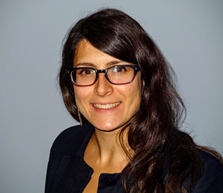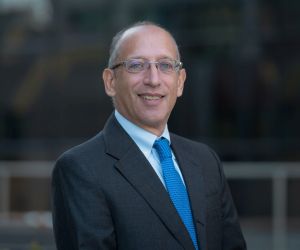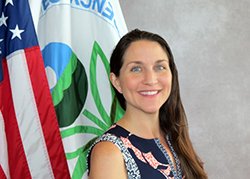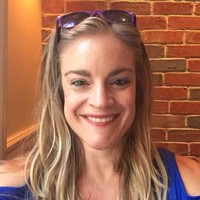Integration of Resiliency and Sustainability into Remedy Evaluation, Design, and O&M: A Compilation of Case Study Findings
Sponsored by: Society of American Military Engineers (SAME) Denver Post, SAME Philadelphia Post, and US EPA
Archived: Wednesday, May 13, 2020
The Society of American Military Engineers (SAME) Denver Post and Philadelphia Post along with the US Environmental Protection Agency (EPA) are hosting a series of webinars based on talks given at recent Design and Construction Issues at Hazardous Waste Sites (DCHWS) Symposiums. The mission of the DCHWS symposiums is to facilitate an interactive engagement between professionals from government and the private sector related to relevant and topical issues affecting applications of engineering and science associated with cleaning up hazardous waste sites. The symposiums also serve as a platform to facilitate the exchange of information, encourage dialogue, share experiences, and build and enhance communication among design and construction professionals.
The role sustainability and resiliency play in a cleanup project is dependent upon site-specific physical characteristics and stakeholder concerns. However, the overlying framework to evaluate and implement sustainable resilient remediation practices is applicable to all site types. This technical presentation will start with an overview of the sustainable resilient remediation framework, and recent guidance updates and initiatives. Followed by four case studies that highlight integration of resiliency and sustainability at various phases of the project life cycle:
- Case Study #1: Combining Green and Sustainable Remediation (GSR) Evaluations with Cost/Risk Analysis as Effective Communication Tools to Drive Cleanup Decisions
- Case Study #2: GSR to Inform Technology Feasibility Assessment & Incorporating Climate Change into Remedial Design and Performance Monitoring
- Case Study #3: Development of Resiliency Remedial Design Guides for a Sediment Site Informed by Stakeholder Engagement at Remedial Action Workshops
- Case Study #4: Hydrodynamic Modeling to Support Remedial Design Utilizing EPA's Stormwater Management Model (SWMM) Climate Adjustment Tool (CAT)
Opportunities to ask questions will be interwoven throughout the presentation. The presentation will end with lessons learned from other cleanup project experience, followed by Q&A.
The target audience for this technical presentation includes environmental regulators at all levels of government, private and public responsible or obligated parties (Ops), current site owners and operators, environmental consultants, and prospective purchasers of property and their agents. Other stakeholders who have an interest in a property can also use this guidance to help understand how sustainable resilient remediation practices can be applied.
Upcoming Design and Construction Issues at Hazardous Waste Sites (DCHWS) Series Webinars
Design and Construction Issues at Hazardous Waste Sites (DCHWS) Series Archives
- Ten Years of Optimization of the Environmental Restoration program at a DoD Facility in North Carolina (Sep 15, 2021)
- Risk Management During the Cost Estimating Process (Jul 14, 2021)
- Increasing Treatment Certainty while Controlling Remediation Cost - Case Studies using Hydraulic Fracturing to Deliver Amendments at Low-Permeability Sites (Jul 14, 2021)
- Design and Construction Issues at Hazardous Waste Sites Webinar on Successful Remedial Design, Session 2 (May 12, 2021)
- Design and Construction Issues at Hazardous Waste Sites Webinar on Successful Remedial Design, Session 1 (May 12, 2021)
- An Environmental Cold Case Detective Story: Discovery and Repair of the Soil Cover on the Cell 3 Landfill (Apr 28, 2021)
- 2021 Design and Construction at Hazardous Waste Sites Virtual Symposium (Apr 1, 2021)
- 2021 Design and Construction at Hazardous Waste Sites Virtual Symposium (Mar 31, 2021)
- 2021 Design and Construction at Hazardous Waste Sites Virtual Symposium (Mar 29, 2021)
- EPA Region 2 Forty Years to the Finish - A Case Study of Combe Fill South Landfill Superfund Site (Jan 13, 2021)
- 2020 Design and Construction at Hazardous Waste Sites Virtual Symposium: Panel 5 and Panel 6 (Oct 28, 2020)
- 2020 Design and Construction at Hazardous Waste Sites Virtual Symposium: Panel 3 and Panel 4 (Oct 27, 2020)
- 2020 Design and Construction at Hazardous Waste Sites Virtual Symposium: Panel 1 and Panel 2 (Oct 26, 2020)
- Former BICC Cables Site Construction Hudson River Sediment Cap Under the EPRI Building Yonkers, Westchester County, New York (Jun 10, 2020)
- Integration of Resiliency and Sustainability into Remedy Evaluation, Design, and O&M: A Compilation of Case Study Findings (May 13, 2020)
- Heat Enhanced Hydrolysis of Energetic Compounds and Field Results (Apr 8, 2020)
- Reducing Cost Risk in Remedial Action Budgets Using Supplemental Analyses (Mar 11, 2020)
- Investigation, Design, Construction, and Optimization of a Large-Scale Combined In Situ Thermal Treatment and Enhanced Bioremediation Remedy (Feb 12, 2020)
- An Overview of the Fundamentals of Sequence Stratigraphy and its Application to Developing Robust Conceptual Site Models and Remedial Strategies (Jan 15, 2020)
- Construction Manager Perspective: Lessons Learned Implementing the Superfund Job Training Initiative (Super JTI) (Dec 11, 2019)
- Substrate Longevity and Long-Term Performance of Biochemical Reactors for Passive Treatment of Mine-Impacted Water (Nov 25, 2019)
- Harnessing Natural River Processes to Remediate 120 km of the Big River in Jefferson County, Missouri (Sep 25, 2019)
Accessibility, Recording, and Content Disclaimer
Rehabilitation Act Notice for Reasonable Accommodation
It is EPA's policy to make reasonable accommodation to persons with disabilities wishing to participate in the agency's programs and activities, pursuant to the Rehabilitation Act of 1973, 29 U.S.C. 791. Any request for accommodation should be made to Kate Garufi at 703-517-5857 or garufi.katherine@epa.gov, preferably one week or more in advance of the webinar, so that EPA will have sufficient time to process the request. EPA would welcome specific recommendations from requestors specifying the nature or type of accommodation needed. Please note that CLU-IN provides both alternate phone call-in options and closed captioning for all webinars, and requests for these specific accommodations are not necessary.
Webinar Recording
By participating in this CLU-IN webinar, you automatically agree to authorize recording of audio and visual content presented during this live event and consent to subsequent use of this recording in the public domain by the U.S. Environmental Protection Agency. This recording may include questions, comments and poll responses provided by you during the live event in addition to your name, voice, image or likeness. This recording will be made available after the conclusion of the live event as part of the CLU-IN webinar archives, and will remain available indefinitely. If you do not wish to consent to the recording, please do not join the live event, and contact Jean Balent at 202-566-0832 or balent.jean@epa.gov to discuss your concerns.
Content Disclaimer
This webinar is intended solely to provide information to the public. The views and opinions expressed as part of this webinar do not necessarily state or reflect those of the U.S. Environmental Protection Agency. It is not intended, nor can it be relied upon, to create any rights enforceable by any party in litigation with the United States, or to endorse the use of products or services provided by specific vendors. With respect to this webinar, neither the United States Government nor any of their employees, makes any warranty, express or implied, including the warranties of merchantability and fitness for a particular purpose, or assumes any legal liability or responsibility for the accuracy, completeness, or usefulness of any information, apparatus, product, or process disclosed, or represents that its use would not infringe privately owned rights.
Presenters:
 Melissa Harclerode, PhD, BCES, CDM Smith (harclerodema@cdmsmith.com)
Melissa Harclerode, PhD, BCES, CDM Smith (harclerodema@cdmsmith.com)
Dr. Harclerode is an Environmental Sustainability Scientist and Technical Specialist for CDM Smith. She specializes in the development of innovative risk management solutions that maximize sustainable and resilient project outcomes.
She is a past at-large board member for the Sustainable Remediation Forum (SURF). She received her BS from Muhlenberg College in Environmental Science and Biology, MS in Environmental Science from Rutgers Unv/NJIT Newark, and PhD from Montclair State Unv in Environmental Management, Evaluating Sustainable Aspects of Hazardous Waste Remediation.
 Mitchell Heineman, CDM Smith
Mitchell Heineman, CDM Smith
Mr. Heineman has three decades of experience in hydrology, hydraulics, and collection systems analysis. He has developed sewer and drain system models in 60 communities worldwide using the EPA Stormwater Management Model (SWMM), InfoWorks, and other modeling software. He has made numerous contributions to the development of SWMM over three decades and has been a leading contributor to the SWMM Users online community. He is the principal developer of CDM Smith's NetSTORM software, which is used for precipitation frequency analysis, SWMM pre- and post-processing, and collection system modeling. From 2008-2010 he was CDM Smith's Collection Systems Subdiscipline leader, and from 2011-2013 he was its Water Resources Discipline leader. Since 2015 he has been a Senior Technical Advisor for the firm's water resources practice. In these roles, he has fostered technical expertise and information sharing across the firm. Mr. Heineman has taught in academic and professional settings, including semester and short courses, and has served on various municipal and national professional committees. He has an MS in Water Resources Engineering from Stanford University and a BS in Geology and Geophysics from Yale University.
Moderators:
 Jean Balent, U.S. EPA Technology Innovation and Field Services Division (balent.jean@epa.gov or 202-566-0832)
Jean Balent, U.S. EPA Technology Innovation and Field Services Division (balent.jean@epa.gov or 202-566-0832)
Ms Balent is on the staff of the EPA's Technology Innovation and Field Services Division where she has worked to collect and disseminate hazardous waste remediation and characterization information since 2003. Ms Balent manages the Clean Up Information Network website and actively supports online communication and collaboration resources available to EPA. She formerly worked with the US Army Corps of Engineers Environmental Engineering Division in the Buffalo District. Ms Balent was also a member of the SUNY-Buffalo Groundwater Research Group where she constructed and tested large scale models of groundwater flow. Ms Balent has also conducted research relating to the Great Lakes, environmental remediation, and brownfields re-development. She holds a Bachelor's degree in environmental engineering from SUNY-Buffalo and a Master's degree in Information Technology from AIU.
 Kate Garufi, EPA OSRTI (garufi.katherine@epa.gov or 703-517-5857)
Kate Garufi, EPA OSRTI (garufi.katherine@epa.gov or 703-517-5857)
Kate Garufi, a project management professional, is the Rocky Mountain region remediation lead for HDR based out of Denver, Colorado. In this role, Kate partnerswith federal clients, including the U.S. Environmental Protection Agency and U.S. Army Corps of Engineers, and industrial clients on complex remediation projects. Prior to joining HDR, Kate spent 16 years at the EPA Headquarters in the Office of SuperfundRemediation and Technology Innovation. At EPA, she was a Superfund program expert in Superfund site management, design and construction project delivery, and technical project scoping. She holds a master's degree in environmental engineering from John Hopkins University and a bachelor's degree in chemical engineering from Virginia Tech
Webinar Slides and References:
Webinar Slides and References:
Additional Resources:
If you have a suggested topic or idea for a future CLU-IN internet seminar, please contact:
Technology Integration and Information Branch
PH: 202-566-0832 | Email: balent.jean@epa.gov
Technology Integration and Information Branch
PH: 202-566-0875 | Email: adam.michael@epa.gov





